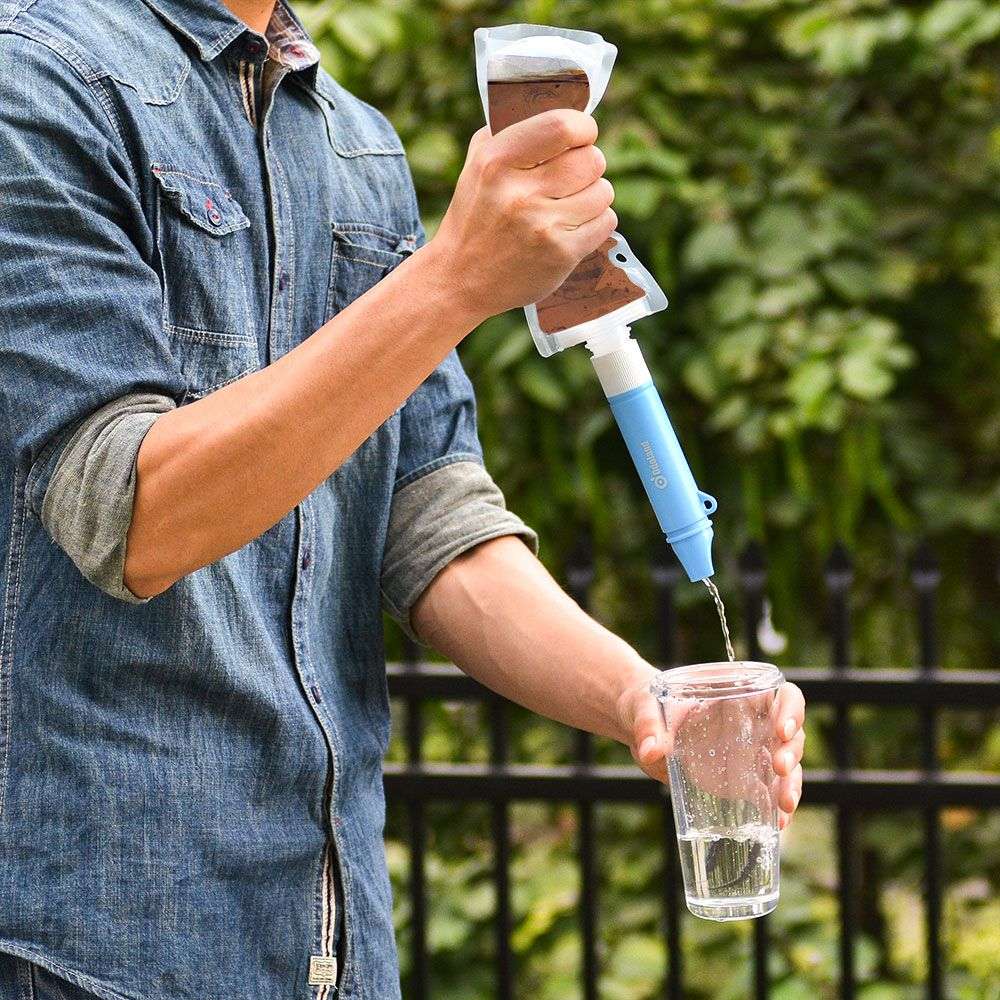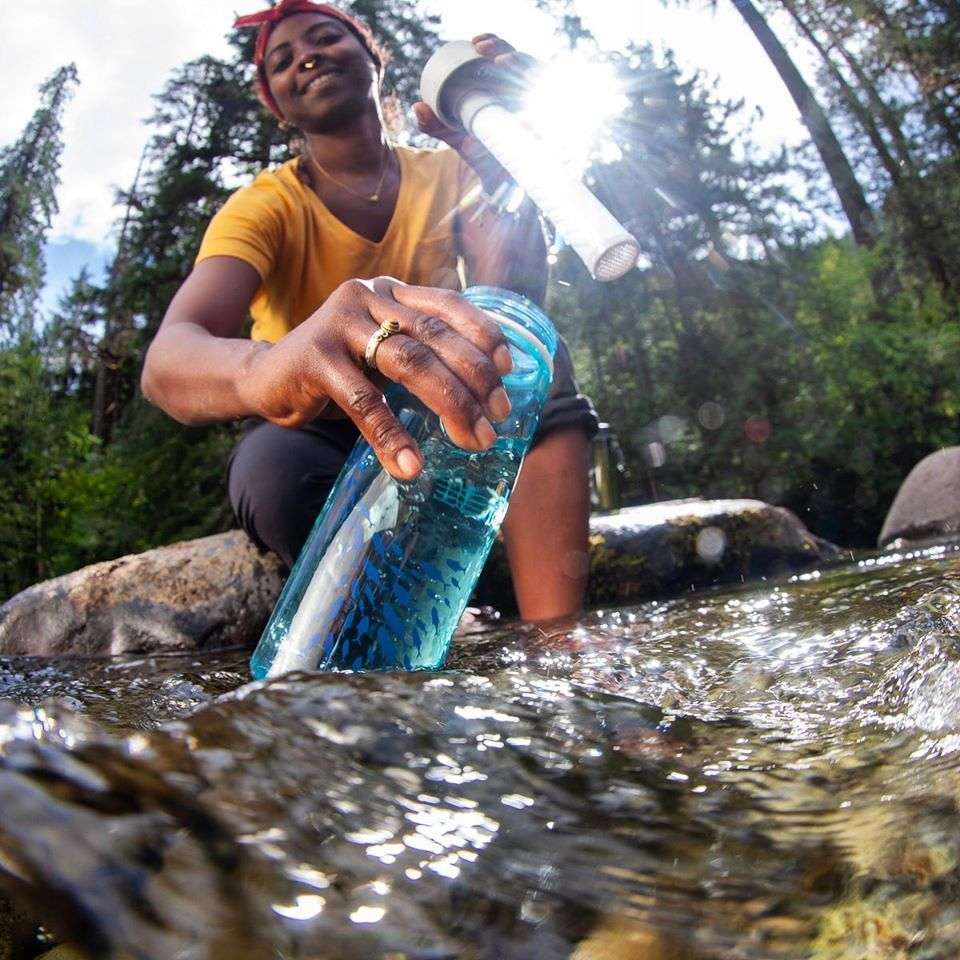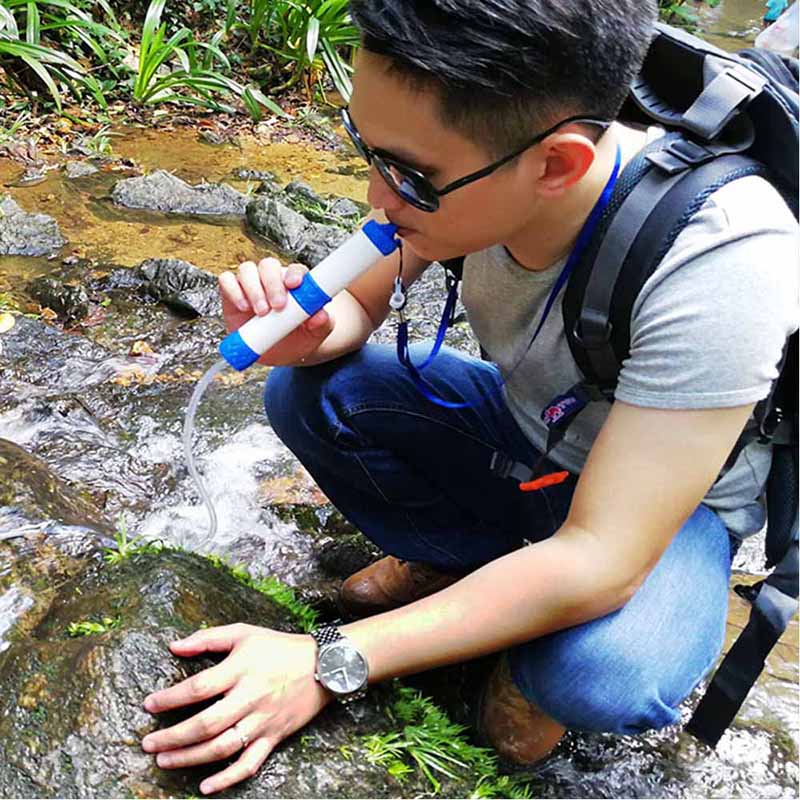What Happens If I Drink Untreated Water
Often nothing. You could get lucky quite a few times before you ingest something you shouldnt. But you could get seriously ill from drinking water that has not been purified.
There are several serious diseases you can get from untreated water sources. These include Hepatitis A and Escherichia coli .
But the most common problem is sickness and diarrhea. This is usually caused by the two most common internal parasites cryptosporidiosis and giardiasis. Diarrhea, may initially seem like just an inconvenience, but if not treated it can lead to death, primarily due to dehydration.
Purify Water Before Drinking
The stream youre camping beside may look pristine, but parasites may be lurking in the water. When you drink contaminated water it can make you sick, causing some pretty unpleasant symptoms. Before drinking from any water source in the great outdoors, it is absolutely essential that you purify the water. This can be done in a number of ways.
1. Boiling water is a surefire way to kill bacteria, viruses and protozoa in the water that can make you sick. Make sure that you bring the water to a rolling boil for at least one full minute before drinking.
2. Chlorine or iodine tablets are a space-saving and effective way to purify water. Water purification tablets should be dropped directly into a bottle of water and, after a period of time , the water is safe to drink. Follow the instructions included with your purification tablets.
3. UV light purification systems: Small, lightweight UV purification systems, such as the SteriPEN, are popular with hikers. The UV light of the SteriPEN disrupts the DNA of the bacteria, viruses and protozoa lurking in the water, rendering them harmless. To use the SteriPEN, turn the device on, wait for the light indicating it is ready for use, and stir the pen in your bottle of water until the light turns off.
*Saltwater is not easily desalinated but can be boiled to kill dangerous parasites and remove some salt.
Recommended: The 13 Best Waterfall Hikes for Spring
How To Purify Water When Canoe & Kayak Camping
3-minute readNo matter how clear and clean backcountry water looks, theres no guarantee its safe for people to drink. Microorganisms in wilderness waters can cause an array of nasty consequences, from mild to severe.
Purifying your drinking water in the backcountry is essential
When you canoe, kayak or kayak fish on a long day trip, its probably feasible for you to take drinking water along. But when youre on a multi-day tripespecially when portaging is involvedyou dont want the haul water around with you.As paddlers, our supply of water is unlimited. The key is to make sure that water is purified and safe to drink.
Don’t Miss: Best Arkansas State Parks For Rv Camping
Have A Dedicated Pair Of Sleep Clothes
After youve given yourself a baby wipe shower, put your sleep clothing on. To keep your sleep clothing clean, it should never leave the tent . Some people will cook over a fire or set up their tent in the same clothing they sleep in. *Shakes heads.* Dont do it!
Things like pollen and campfire smoke cling to clothing fibres and you dont want these on your skin when youre sleeping . Also, if you are outside your tent and accidentally get your sleep clothing wet, what will you sleep in? Have an extra pair of pants/shorts and an extra t-shirt exclusively reserved for sleeping.
Tip: Avoid sleeping in cotton clothing if it gets wet itll chill you down and never dry. I like to sleep in a set of merino wool base layers specifically this top and these bottoms.
Read more: 10 Tips for Comfortably Sleeping in a Tent
Visiting Zion National Park: A Few Lesser Known Hikes

Yep, finding open water in winter can be difficult and when you start looking out on the ice, it can be dangerous. And in the backcountry accidents on ice are usually deadly.
Though snow melting is a fantastic way to “make water,” it has a high fuel cost and is time-intensive. Therefore, whenever an open source of water can be safely accessed, it is more energy and time-efficient.
First of all, be careful whenever venturing onto or nearby ice. Test the ice with a trekking pole and try to stand on logs or rocks as you dip or chip into the ice. Again, standing in the middle of a pond, hammering on the ice with an ax may not be the best idea.
Often fast-moving streams are good sources of easily accessed water as the ice generally isn’t too thick.
Extend your reach by attaching your water bottle to the end of your trekking pole. To do this use a small piece of paracord to tie the bail of your wide-mouthed Nalgene to the end of your trekking pole. For the knot-challenged, use a carabiner to clip the canteen to the hiking pole wrist strap. Sometimes the bails wear out on Nalgenes, so tie a small piece of paracord below the threaded lip for water dipping.
Melting snow to make water is a laborious and time consuming activity for winter backpackers.
If you plan on melting snow and cooking, plan on carrying about 8 oz. of fuel per person per day for your white gas stove.
Note: stove fuel economy differs between models so field test your stove before using it in the backcountry.
You May Like: Where To Rent Camping Gear
Is The Water At Campsites Drinkable
It is probably safe to drink, but it sure isnt enjoyable to drink. We have also noticed some water didnt leave our clothes or dishes very clean. Also, your gut gets used to the microorganisms and chemicals in your local water. When you move around as much as we do, your body is constantly trying to adjust.
Stay Hydrated On The Trail With These Water Purification Options
A long hike or multi-day backpacking trip requires plenty of hydration and unless you want to weigh down your pack with water you should plan on bringing a water filtration or purification method. The options for purifying water in the backcountry have never been lighter or easier with solutions ranging from ultralight squeeze filters to high tech UV purifiers. Here we will look at 6 popular options for purifying water on the trail, so you can keep hydrated and happy on your next hiking or backpacking trip.
Don’t Miss: Hillsborough River State Park Camping
Wash Your Hands Regularly
Yes, even in the woods you should be washing your hands after you go to the bathroom and before you start cooking. There are a few ways to do this.
Hand Sanitizer The most lightweight option is to bring hand sanitizer and use that periodically.
Hand Washing Station If youre in a group and can spare more gear, you can set up a handwashing station. Hang a small water reservoir from a tree and keep a little biodegradable soap nearby.
The last thing you want is to accidentally get some crap on your hands, get that in the food and have a sickness epidemic while youre on your trip!
Now That You Know How To Purify Water While Backpacking Youre Ready For Your First Backpacking Trip
Even if youve already got an overnight hiking trip or two under your belt, be sure to check out my guide with 7 Tips for Conquering Your First Backpacking Trip and my other super practical backpacking articles .
You can even get a free printable to help you plan your first backpacking trip!
And dont forget to send me a message on and to share some stories from your first backpacking trip!
You May Like: Camping World Of Houston Katy
Stock Up On Paper Products
Eco-minded RVers find that RV dry camping is a trade-off. Water can be used to rinse reusable dishes, or for more important things like cooking.
Unfortunately, when you try to save water when dry camping, one of the best ways to do that is to eat off paper plates and pre-wash cooking implements with paper towels. Also, you can burn them in a campfire and avoid sending it to the landfill.
Kettle Over A Campfire
Estimated Time : 4 to 5 minutes for a 1-liter kettle
The most typical way campers boil water while in the great outdoors is using a kettle over a campfire. Most camping kettles are about 1 liter in size, which means its going to take about 5 minutes when filled to the top and placed over high heat. Larger kettles will obviously take a little more time to boil.
Be careful not to go too large, because when filled with water, it could be too heavy to easily pour out the water.
The kettle is preferred because its easy to pour boiled water for coffee and cooking things like oatmeal and rice. Make sure youre wearing a protective glove to avoid burning your hand on the handle when pouring.
Make sure you have a grill plate to put over the campfire ring so your kettle has a stable table to heat up on. Go with a cast iron grill plate for durability.
Don’t Miss: Best Camping Spots In Alabama
Types Of Water Filters And Water Purifiers
Quick Reference Guide to Water Filters and Purifiers
|
Method |
- The only additional supply you need to pack along is extra fuel.
- Murky water doesnt impair effectiveness.
- Serves as a readily available backup method in case your main filter breaks.
Cons:
- Time and effort required to bring water to a boil.
- Wait time for the water to cool.
- If its your primary treatment method, you need to pack an extra fuel container.
How Do You Purify Dirty Water

4 Methods to Purify Your Water 1 Boiling. Boiling water is the cheapest and safest method of water purification. 2 Filtration. Filtration is one of the effective ways of purifying water and when using the right multimedia filters its effective in ridding water of the compounds. 3 Distillation. 4 Chlorination.
Recommended Reading: Cherry Springs State Park Camping
That Stream Looks Clean
Remember that backpacking trip a couple of weeks ago when you drank directly out of that pristine mountain stream that cascaded through a thousand glistening stones? Now forget that sublime moment and think about where you are nowsitting on the toilet for the past three days. You should have purified your water!
The tricky thing about water is that it doesn’t matter how “clean” it looks, you can’t see those nasty little microorganisms .
In this article, we’ll review the advantages and disadvantages of the most popular water purification and treatment methods for backpacking and camping. For those of you without an inclination for the wilderness, the ability to purify water is a critical emergency skill that everyone should master. You never know when disaster will strike.
An electron micrograph of giardia.
Dr Stan Erlandsen CDC via Wikimedia Commons
In an age when man has forgotten his origins and is blind even to his most essential needs for survival, water along with other resources has become the victim of his indifference.
Rachel Carson
How To Wash Dishes While Camping
Even in the wild, you should be washing your dishes. This is to prevent bacteria growth or mould .
Note: If your campsite has a thunderbox, do NOT dump your dishwater in the thunderbox! We dont want animals smelling the food and hanging around where we go to the bathroom!
And there you have it! An easy way to do dishes on a camping trip.
Read Also: Camping Sites Near San Francisco
What Is The Best Water Purification Method
So, which method for purifying water is the best for your next backpacking trip? As you can see, there are advantages and disadvantages to each method and nothing is absolutely perfect.
Personally, when I’m hiking by myself I either use Aqua Mira or a SteriPEN UV light. However, when I’m out canoeing or backpacking with a group, I always filter the water first with a Katadyn Hiker. Sometimes, if the water source is extra questionable, I’ll treat the filtered water with my SteriPEN.
This content is accurate and true to the best of the authors knowledge and is not meant to substitute for formal and individualized advice from a qualified professional.
Why Is Water Purification Important
Do a little research on the pathogens you can find in water and you wont want to drink it without purifying first! You can find all kinds of nasty stuff in natural sources of water with virus, bacteria and protozoa the most common. You can also pick up a parasite or consume toxins.
The World Health Organization breaks down the potential pathogens you can find in untreated water below:
- Bacteria, viruses, protozoa and helminths with the exception of Schistosoma.
- Potentially emerging pathogens, including Helicobacter pylori, Tsukamurella, Isospora belli and microsporidia, for which waterborne transmission is plausible but unconfirmed.
- Bacillus, which includes the foodborne pathogenic species Bacillus cereus for which there is no evidence at this time of waterborne transmission.
- Hazardous cyanobacteria.
It is important to remember how lucky we are to have clean drinking water from a tap. Around 3.4 million people die every year around the world due to drinking contaminated water. There are various charities working to stop this, check out Wateraid if you would like to help.
You May Like: Best Tent Camping In Southern California
Where To Gather Water
What to look for in a water source:
- Flowing water, especially in a stream or river. This is a good option because it isnt conducive to the growth of algae or the accumulation of microorganisms. A bonus is that mosquitoes dont lay eggs in fast-flowing water.
- If no clear flowing source is available, then look for calm water without a lot of sediment or silt. Clearer water passes through a filter more swiftly and reduces the chance of clogging.
- A location that allows you to reach well away from the shore, where microorganisms tend to accumulate in higher concentrations.
Tip: After a heavy rain, wait before gathering water for treatment. When streams are on the rise, rain has washed surface material into them, as well as lakes and other water sources. This increases bacterial loads and muddies up gathered water.
Danger signs in a water source:
The following tipoffs suggest a much greater likelihood of contamination. If you can choose another water source, do so. If not, then follow water treatment directions for your product carefully.
Purifying Water While Camping
Water is full of bacteria, protozoa, viruses, dirt, and sometimes harmful chemicals. Water filtration devices have come a long way, making it pretty easy to select the perfect style for your situation.
Each method has its advantages- for example, you wouldnt want to share a LifeStraw with a group of 5 campers, nor would you want to use a squeeze method to supply water for a group of 10 people for a week in the woods.
There are really only three ways to neutralize the water, theyre just packaged differently. You can force the water through really small holes to filter out anything larger than a micron or two, you can add chemicals to the water to nuke it, or you can use heat or light to sterilize it.
Water Purification vs. Water Filtration
A note on water purification versus water filtration- all of these devices filter water, but not all of them purify it. The purification process requires chemicals to kill the smallest viruses that can pass through some filters.
The viruses of concern to humans are pretty much only passed through human feces, so if youre camping mostly in the US and Canada you should be just fine with a water filter. If theres any concern that the water could be contaminated with human feces, its best to be extra cautious and go with a method that purifies the water with chemicals as well.
Recommended Reading: Dog Friendly Camping Southern California
Does All Water Need To Be Treated
As a golden rule of thumb, you should treat all water you collect while camping, backpacking, or hiking out in the woods.
Its better to be safe rather than sorry and to treat all natural water that you collect for bacteria, pesticides, toxins, and chemical contaminants. This is especially true if you find yourself in a survival situation without guaranteed or quick access to professional medical help.
You may be wondering – what happens when you drink contaminated water?
How To Boil Water When Camping: 5 Reliable Methods

It is crucial to know how to boil water when camping. Well, to do so, access to potable water is essential. Some campers bring many liters of water with them to not have to worry about finding water clean enough to drink while camping. However, there are situations when this is not possible.
When camping, it is necessary to know how to boil water. You must boil water to destroy all hazardous bacteria and ensure safe drinking. There are numerous methods for boiling water when camping. A few of them are described below.
Contents
You May Like: Itasca State Park Rv Camping